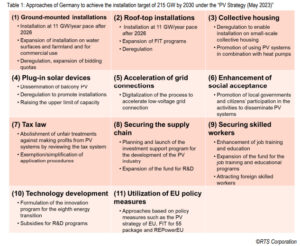In the RTS Monthly Perspective in the July 2023 issue of this report (June 2023 issue in the report in Japanese), we compared the policy frameworks of the USA, Germany and Japan, which will lead the expansion of introduction of PV power generation in the future among the G7 countries. Out of these three countries, Germany has legislated a target cumulative PV installed capacity of 215 GW by 2030 under the Renewable Energy Sources Act (EEG) 2023 as it needs to accelerate the introduction of PV and wind power generation drastically to achieve netzero greenhouse gas (GHG) emissions by 2045, which is stipulated in the Revised Climate Protection Act.
The Federal Ministry for Economic Affairs and Climate Action (BMWK) of Germany formulated the PV Strategy to achieve this ambitious target, presenting a scenario that calls for a gradual expansion of installation to 22 GW/year by 2026, three times as much as that of 2022, and then maintaining the 22 GW/year level every year thereafter until 2030. Out of the 22 GW/year installation target, the targets for both ground-mounted systems and rooftop systems are set at 11 GW/year each, based on the evaluation that the needs of deploying these two types of systems are equal. In addition, BMWK set milestones of cumulative installed capacity by every two years, against the PV installed capacity of 67.4 GW as of 2022: 88 GW in 2024, 128 GW in 2026, 172 GW in 2028 and 215 GW in 2030.
As shown in Table 1, the strategy to achieve the 2030 installation target is composed of the following eleven fields of action: 1) Ground-mounted installations; 2) Roof-top installations; 3) Landlord-to-tenant electricity supply and joint supply for buildings (promoting installations on collective housing); 4) Balcony PV installations (promoting dissemination of plug-in solar devices); 5) Grid connections (acceleration of grid connections); 6) Public acceptance (enhancement of social acceptance); 7) Tax law; 8) Industry (securing the supply chain); 9) Skilled labour (securing skilled workers); 10) Technology development and 11) European level (utilization of EU policy measures). For each field, under the specific target, measures currently being taken and future steps and measures to be taken are clearly described. For ground-mounted PV, toward the target of installing at a pace of 11 GW/year from 2026 onward, measures are specified including raising the maximum bidding price, deregulation of installation locations and promotion of installations on farmland, parking lots, water surfaces and wetlands. Rooftop PV systems will be installed, keeping the 11 GW/year pace by applying and expanding the highlevel FIT and by deregulating installations on buildings, with the aim of expanding into new markets such as collective housing and power generation at balconies.
Also, the German PV strategy has been developed so that it can demonstrate the combined power of various sectors from a broad perspective, including digitization of processes to accelerate grid connection, enhancement of social acceptance of PV power generation by local governments and citizens, review of the tax system, investment support for the development of the PV industry, securing human resources and promotion of technology development.
Meanwhile, in Japan, for the expanding introduction of PV power generation, activities to achieve the cumulative installed capacity of 120 GW are in progress in accordance with the introduction targets set in the Sixth Strategic Energy Plan. The Ministry of Economy, Trade and Industry (METI), the Ministry of the Environment (MoE), the Ministry of Land, Infrastructure, Transport and Tourism (MLIT), the Ministry of Agriculture, Forestry and Fisheries (MAFF) and other related ministries and agencies are playing their roles in the sectors under their respective jurisdictions to achieve the target, by mobilizing every means such as policy measures, budget (including subsidies), development of legal systems and regulatory reform.
As a result, the Japanese PV market has been shifting from “gross sales of electricity” to “self-consumption” and the new markets are emerging, such as the markets for parking lots, collective housing, farmland (including AgroPV), water surfaces, public infrastructure spaces such as roads and railroads, in addition to the markets established under the former Feed-in Tariff (FIT) program, such as the markets for detached houses, public facilities, private facilities including factories and commercial buildings and groundmounted systems.
Development and establishment of these markets are extremely important for achieving the 2030 installation target. Furthermore, looking ahead to the continuous expansion of PV introduction after 2030, it is necessary for the public and private sectors to cooperate in developing the effective Japanese version PV Strategy from a multifaceted perspective, including policy, industry, market, tax system, finance and social acceptance, like the German PV Strategy. The concerted efforts of the public and private sectors to disseminate PV power 2 generation based on this strategy will encourage the development of the PV industry and its adoption and deployment by citizens, businesses, and other electricity consumers, and will be the driving force for the GX Promotion Strategy (approved by the Cabinet on July 28, 2023) that the government will pursue hereafter.

©RTS Corporation
